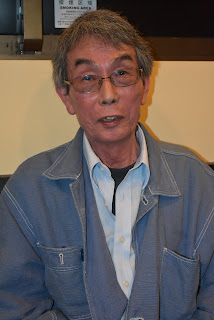A view of Cape Inubo from a distance. Photo by Brett Homenick.
Today, I traveled deep into Chiba Prefecture to the city of Choshi. My purpose was to visit Cape Inubo, a rather scenic location with a historic landmark, Inubosaki Lighthouse.
Inubosaki Lighthouse. Photo by Brett Homenick.
As interesting as Inubosaki Lighthouse is, I have to admit that the real reason I went all the way out there was to try to take a look at the rocks used for the Toei logo. What I wasn't counting on was just how difficult those particular rocks are to get to.
I imagined it would probably be fairly simple to access. I mean, it's just a beach, right? Wrong. It's very rocky, but not only that, some parts of the beach are closed off. The parts that weren't closed off were a bit too treacherous for me to try. I love movie history, but even I have my limits.
I tried getting to the Toei rocks from a view different angles, but after a while, I had to throw in the towel. There was just no way I it was going to happen, especially with camera in hand. Perhaps if I had a waterproof GoPro, I would have tried it.
Other than that, it was a beautiful location. I enjoyed seeing a different side of Japan that often gets overlooked. But given how remote this location is, I'm not surprised that it gets overlooked!
Nature wins this round. Photo by Brett Homenick.
As much as I would have loved to see the Toei rocks, the photo above demonstrates why that just wasn't going to happen. This is probably not a place you'd like to slip and fall on.
Inubosaki Marine Park Aquarium. Photo by Brett Homenick.
A stone's throw from the Inubosaki Lighthouse is what's left of Inubosaki Marine Park Aquarium. The park closed in January 2018, but based on what it looked, I would have guessed it had been closed for quite a bit longer than that. It's quite a depressing sight to see.
Well, I may not have gotten to see the Toei rocks, but I did get to see this baby dinosaur hatch outside an abandoned aquarium. What a day!


















































